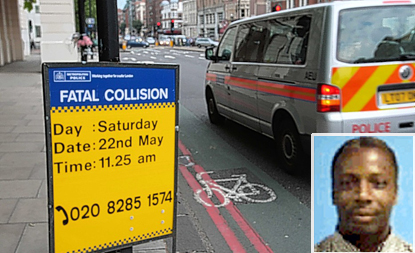TfL are an optimistic organisation. They believe things can be better for everyone. They might build infrastructure which is actively hostile to cyclists, recently for example here, here, here, here, here, here, and of course here. But this is no obstacle to bombarding us with material endorsing cycling as the provocative choice of the insouciant, the glamourous and the ever-so-slightly seductive, like in this image promoting June 2011’s TfL Cycle Challenge:

I would.
TfL’s claim that they can cram as much motor traffic as possible on to our streets, while still effectively promoting cycling and walking, is perhaps crystallised in this quote:
“It is imperative that the road network functions effectively both as a set of corridors for traffic movement and as a collection of places in which people live, work and play.” – p4, TfL Draft Network Operating Strategy (pdf), May 2011
I wonder whether the authors of this strategy (TfL Directors Garrett Emmeson and Ben Plowden) really imagined this was persuasive. I doubt even estate agents would try it:

“The cosy upstairs property is situated by a charming traffic corridor for when little Jenny starts to toddle…”
Smoothing traffic flow and accessibility for pedestrians cannot both be priorities – this is not controversial. It is why parenting groups spend time campaigning for traffic reduction. Even the relatively regressive City of London Local Implementation Plan accepts that decisions favouring a particular group are necessary:
The City of London intends that its streets are safe and accessible for all road users… There is however not the capacity to give all road users the space and facilities that they may want.
Choices that are made about street design are political ones – in the sense that they inevitably privilege the interests of one group of road users over another. For a more insightful analysis of this than I could hope to provide, read this fantastic blog post.
So, what does this have to do with Blackfriars?
The interesting thing about Blackfriars is that at first TfL pretended that there was basically no decision to make. When we found out in February 2011 about the plans to redesign the bridge, we were told that they were set in stone and had been agreed upon last year. They were initially only willing to “consult” about one right-hand turn on the bridge, which was sent out on a Friday to “interested parties” (i.e. almost no one) with a response required in 3 working days. (The current government’s Code of Practice suggests that consultations should normally be open for at least 12 weeks. They’re also meant to be accessible to those who are being consulted.)
That TfL expected to be able to get away with this can be understood when we look at the other projects that they have managed to pull off, for example this extraordinary campaign:

I'm convinced.
(Six cyclists have been killed by freight vehicles in London so far this year.)
Yes, at Blackfriars TfL were planning to reduce the number of cycle lanes, reduce the width of cycle lanes, remove a pedestrian crossing, increase the number of motor-traffic lanes and increase the speed limit. But who cares? Why should this actually affect cyclists or pedestrians? We can all share the road together. It’s certainly not a political decision which might have negative consequences for anyone.
Of course this is obvious nonsense. Thankfully, Val Shawcross got involved and the media and political scrutiny eventually forced TfL to consult on the proposals for the entire bridge.
And that’s where things became interesting. It was only at this point that TfL came to accept that there might be a conflict between the needs of motor traffic and other bridge users, issuing a letter at the end of February which defended the plans for Blackfriars Bridge due to the need to,
develop a scheme that provides the best balance between the needs of all modes; including pedestrians, vehicles and cyclists.
And then finally, in TfL’s May 2011 response to their consultation on the new proposals, they begin to admit reality:
Reason for reducing the current cycle lane width (2m) to 1.5m: It is not possible to reassign carriageway space to cyclists, or to reduce the number of traffic lanes, without significantly worsening conditions for bus passengers and general traffic.
Reason for scrapping the Watergate pedestrian crossing: Our modelling showed that retention of the temporary crossing opposite Watergate would further reduce the capacity of the junction beyond the point that could be accommodated… through marking out of additional traffic lanes that allow motor vehicles to ‘stack’.
And there’s the rub: TfL are prepared to accept that there are competing interests as a justification for not allocating street space to cyclists and pedestrians.
The myth is shattered. TfL have admitted that street design has winners and losers. No longer can they continue to widen motor-vehicle lanes, demolish pedestrian crossings, bus lanes and cycle lanes, and pretend that they are an organisation which encourages anything other than travelling by car.
So sign the LCC motion before Friday’s debate. And remember: this is just the beginning. Blackfriars is about fighting the dirty, noisy, unpleasant and dangerous car-culture entrenched in our streets and in the minds of our city’s transport policy-makers.
If we win at Blackfriars, it can affect a lot more than just one bridge.















